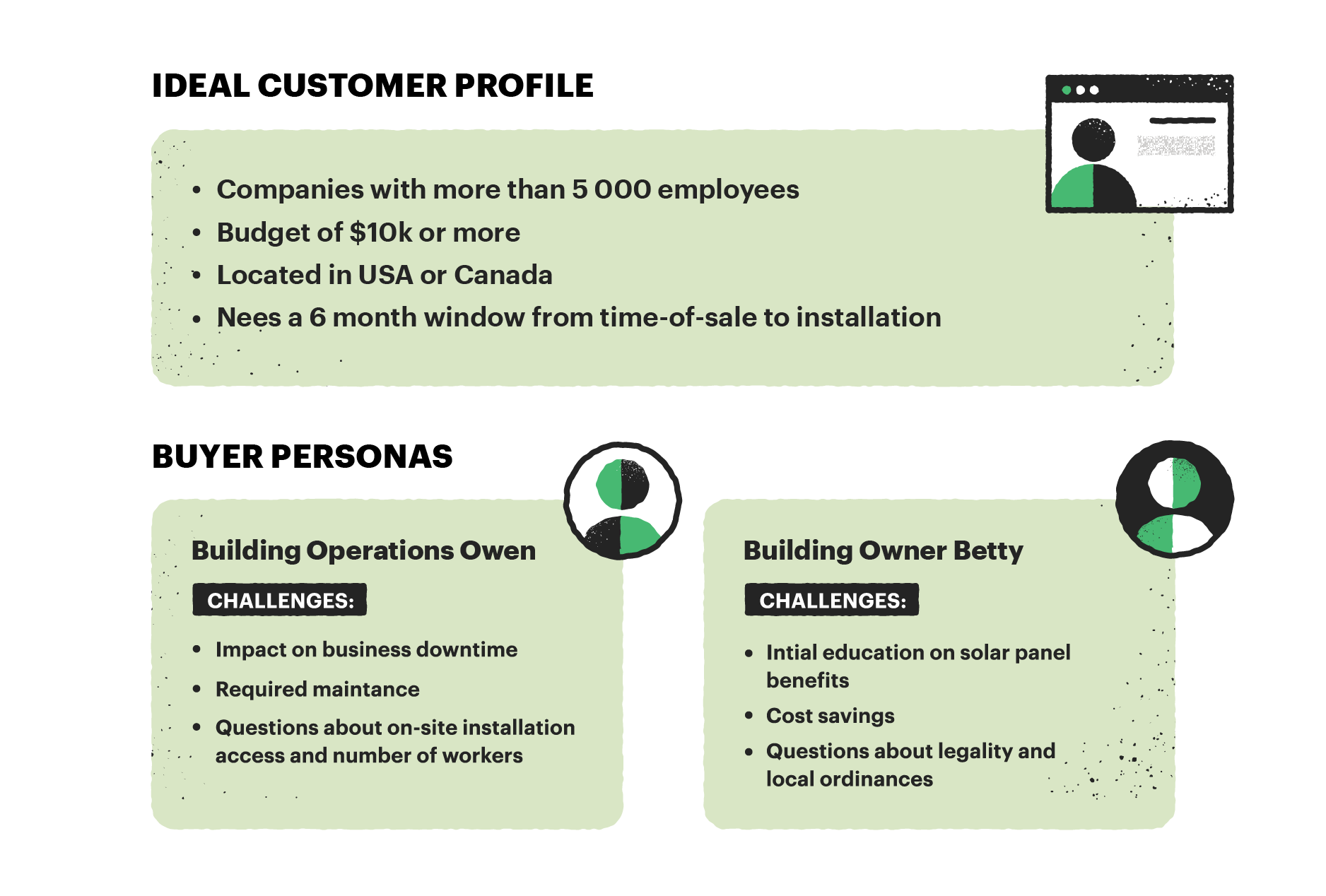Confused by ideal customer profile vs buyer persona? Need to know what they are, the differences between them, and when to use them?
Thankfully, we have compiled some basic ideas to help businesses like yours make the right choice (or no choice at all).
Due to the staggering number of new businesses and potential clients that inhabit the marketplace, companies must know the difference between ideal customer profiles (ICPs) and buyer personas to craft the perfect strategy for using them.
This article will give you a full understanding of all there is to know about ICPs and buyer personas.
Key takeaways
- Buyer persona vs ideal customer profile are two very different concepts.
- ICPs are mainly used to identify the companies that it might be in your best interest to work with and are traditionally used in the B2B industry.
- Buyer personas are created to profile different types of potential clients. They help companies convert leads and establish better client relationships.
- ICP and buyer persona can be used simultaneously.
- You can create a two-step strategy by using ICPs first (to identify which client is your ideal match) and then implementing buyer personas (to get the deal closed and develop excellent customer service).
Why is it important to know the difference between an ICP and a buyer persona?
Despite having played a solid role in business language for almost 30 years, the terms “buyer persona” and “ICP” are often used interchangeably (and incorrectly).
Being able to tell the difference between these two profiling techniques will not only help you understand your clientele better, but it will also give you an edge over those misinformed competitors who do not take their time to explore fully the unique benefits of each idea.
So, let’s get down to the nitty-gritty and start by explaining what “ICP” means.
What is an ICP? Understanding your ideal customers
The definition of ICP is “Ideal Customer Profile.”
Or, to expand, you can define ICP as the characteristics, demographics, and attributes that specify a company’s most valuable and suitable customers, guiding targeted marketing and sales strategies.
B2B companies offer services to other corporations, and their salespeople tend to use ICPs as a business-partner scouting method.
Ok, so what is an ideal customer profile?
These profiles are based on cold, hard facts: general information, statistical data, and firmographic intel.
They include a detailed deconstruction of the main attributes that define your “perfect client.”
Unlike simpler terms, such as target customers (a term that only describes any company that might buy your product or service), ICPs focus on highlighting only the most valuable business stakeholders in the marketplace.
Developing ICPs
To develop a complete ICP, most companies use data mining techniques, statistical analytics, and data quality software with ETL (Extract Transform and Load) tools.
ETL software can analyze, organize, and filter data exceptionally quickly.
Thanks to the effectiveness of these tools, marketing specialists can develop ICPs more efficiently.
However, the automation and digitalization of this process come with a series of new and unique challenges regarding safety software protocols, such as system monitoring, alerts, backups, and vulnerability testing.
No company wants to see this valuable and sensitive information stolen, lost, or leaked.
Luckily, cloud storage services offer a secure database that can categorize, organize, and contrast any data better than old-fashioned binders.
If you choose to use cloud storage, your information will not only be secure, but it will be better organized and more accessible to your marketing teams and sales reps since most cloud storage apps allow you to retrieve documents from any device.
How to create an ideal customer profile in 11 easy steps
Creating an Ideal Customer Profile involves identifying and defining the characteristics of your most valuable and suitable customers. Here are our easy steps to help you create an ICP:
1. Analyze your existing customer base
Review your current customer database and identify common traits among your most profitable and satisfied customers.
2. Segment all customer data
Divide your customers into segments based on industry, company size, geographic location, and purchasing behavior. This segmentation helps identify patterns.
3. Identify key demographics
Determine demographic information such as age, gender, job titles, and income levels that align with your most successful customer segments.
4. Understand psychographics
Explore the psychographic aspects of your ideal customers, including their values, interests, lifestyles, and buying motivations.
5. Assess pain points and challenges
Identify the common challenges and pain points your customers face and how your product or service provides solutions.
6. Evaluate buying behavior
Analyze the buying journey of your best customers. Aim to understand how they discover your product, evaluate options, and make purchase decisions.
7. Gather feedback
Get feedback from your sales and customer support teams to gain insights into customer preferences, objections, and frequently asked questions.
8. Utilize market research
Carry out your market research to identify industry trends, competitive landscapes, and emerging opportunities that align with your ideal customer characteristics.
9. Validate and refine
Continuously validate your ICP based on real-time data, market changes, and feedback from ongoing customer interactions.
10. Communicate with your sales and marketing teams
Ensure that your ICP is shared and understood by both the sales and marketing teams. This is crucial for targeted campaigns and effective customer engagement. Communication is everything.
11. Update your ICP regularly
Regularly revisit and update your ICP to stay up-to-date with evolving market trends, changes in your product or service offerings, and shifts in customer preferences.
4 ideal customer profile examples
ICPs can vary depending on the nature of the business and its target market, but here are some ICP examples across different industries:
1. B2B software company ICP:
- Industry: Technology
- Company size: Mid to large enterprises
- Decision-maker: IT Director or Chief Technology Officer
- Pain points: Scalability issues, outdated software, need for integrated solutions
- Goals: Improve efficiency, enhance cybersecurity, streamline workflows
2. E-commerce fashion brand ICP:
- Demographics: Women aged 25-35
- Geographic location: Urban areas in the United States
- Interests: Fashion-forward, sustainability-conscious
- Buying behavior: Regular online shoppers, interested in limited edition releases
- Goals: Stay on top of fashion trends, support eco-friendly brands
3. Marketing agency ICP:
- Industry: Consumer goods
- Company type: Small to medium-sized businesses
- Decision-maker: Marketing manager or business owner
- Pain points: Limited online presence, need for digital marketing strategy
- Goals: Increase brand visibility, drive online engagement, boost sales
4. Manufacturing equipment supplier ICP:
- Industry: Manufacturing
- Company size: Large factories and production facilities
- Decision-maker: Plant Manager or Operations Director
- Pain points: Outdated equipment, production inefficiencies, compliance issues
- Goals: Increase productivity, reduce downtime, ensure regulatory compliance
What is a buyer persona? The ideal customer
A buyer persona is a semi-fictional representation of an ideal customer based on market research and real data that helps businesses understand and tailor their marketing efforts to specific customer segments.
Buyer personas can be used by both B2B and B2C companies, but they are used mainly by businesses selling to specific individuals.
Instead of being purely based on numbers and stats (like ICPs), buyer personas also include behavioral information, such as the customer’s buying habits, needs, and motivators.
Such information can come from diverse sources like analytics of your website metrics or even social media.
Since buyer personas are commonly used to profile individuals instead of companies, this profiling technique uses demographic info instead of the firmographic intel used for ICPs.
By which we mean an individual’s gender, age, job title, etc. Buyer personas serve as a “fictional representation” of potential real clients.
Buyer personas: Understanding a typical customer
The term “buyer persona” was first used by American software designer Alan Cooper in the late 90s.
Cooper created this concept to help other fellow programmers develop more intuitive software applications (since back in the day most programs were very difficult to use and navigate).
With this in mind, he devised a fictional client named Kathy, an average software user who was not tech-savvy.
This helped software designers understand how to adapt their product (in that case, computer software) for a specific type of client.
This is the essence of buyer personas.
These profiles are used by marketers who want to get inside the heads of different buyers and their potential customer base.
All to promote their products or services and speed along the buying process.
Developing buyer personas
You can develop a more robust buyer persona by simply implementing customer journey data analysis.
This analysis helps companies like yours map your clients’ experience from start to finish, analyzing their preferences and habits.
This information can be used to develop new buyer personas.
Another approach to crafting buyer personas that uses the information you already have is found in Customer Relationship Management (CRM) software.
You can reverse-engineer buyer personas by simply implementing the information you have about your current clients and existing customers (gathered with CRM tools).
Instead of crafting “fictional” client profiles that might help you target specific types of customers, you can simply analyze your clients’ needs and habits to create buyer personas out of their profiles.
Automation and buyer personas
As previously mentioned, automation is the way to go if you want to build accurate, useful buyer personas quickly.
Most companies, including yours, can easily implement bots and automated processes to make the development of buyer personas easier and faster.
You can boost this process by using customer journey data and creating automated responses with the help of Robotic Process Automation (RPA).
This avant-garde approach offers many advantages:
- Greater accuracy and a more personalized approach for every client
- Cost-cutting techniques that do not require as much human interaction
- Improved customer experience during negotiations and after closing deals with customers

How to create a buyer persona: a step-by-step guide
To create a buyer persona you must understand and define the key characteristics of your ideal customer. Here are some simple steps to help you create the perfect buyer persona:
1. Conduct customer research
As with an ICP, analyze your existing customer data, conduct surveys, and gather feedback to understand the preferences, behaviors, and pain points of your current customers.
2. Divide your audience
Identify common characteristics among your customer base and segment them based on demographics, behaviors, and preferences.
3. Create a persona template
Develop a template that includes key information such as the persona’s name, job title, demographics, goals, challenges, and preferred communication channels.
4. Name your persona
Give your persona a name to make it more relatable and memorable, such as “Marketing Manager Mike” or “Tech-savvy Taylor.”
5. Define your demographics
Specify demographic details like age, gender, location, job title, income level, and educational background that align with your target audience.
6. Identify goals and motivations
Understand the goals, motivations, and aspirations of your persona, including both professional and personal objectives.
7. Explore pain points
Identify challenges and pain points your persona experiences with your product or service, helping you tailor solutions to their needs.
8. Consider buying behavior
Analyze the persona’s buying journey, including how they discover products, research options, make decisions, and interact with sales and marketing channels.
9. Add personal details
Include personal details that contribute to a more holistic understanding of your persona, such as hobbies, interests, and preferred leisure activities.
10. Collect and analyze feedback
As when creating an ICP, it is vital to use feedback from sales and customer service teams to gain insights into common objections, frequently asked questions, and areas for improvement.
11. Review and refine
Don’t forget to regularly review and refine your buyer persona based on evolving market trends or changes in customer preferences.
12. Share and align
Always share the buyer persona with relevant teams to ensure alignment and consistent messaging across the organization.
4 buyer persona examples
Buyer persona examples showcase diverse characteristics, goals, and challenges, helping businesses tailor their marketing and sales strategies to meet the unique needs of each target audience. Here are some examples of buyer personas across different industries:
1. Marketing Manager Maggie
- Demographics: Female, 35 years old
- Job title: Marketing Manager
- Goals: Increase brand visibility, lead generation, and effective utilization of marketing budgets
- Challenges: Keeping up with the latest marketing trends, proving ROI to executives
2. Small business owner Oscar
- Demographics: Male, 45 years old
- Job title: Small Business Owner
- Goals: Grow revenue, streamline operations, enhance online presence
- Challenges: Limited resources, time constraints, navigating digital marketing complexities
3. Tech-savvy Tyler
- Demographics: Male, 30 years old
- Job title: IT Manager
- Goals: Enhance cybersecurity, implement scalable solutions, stay ahead in technology trends
- Challenges: Integrating new technologies, ensuring data security
4. Busy parent brian
- Demographics: Male, 40 years old
- Occupation: Parent, full-time Job
- Goals: Convenient shopping, time-efficient solutions, family well-being
- Challenges: Balancing work and family life, simplifying daily routines
What are the key differences between an ICP and a buyer persona?
In summary, ICPs accurately describe the type of company you should try to sell to, and buyer personas are detailed representations of the “fictional profile” of a potential customer.
1. ICPs
ICPs are ideal for businesses that work in the B2B industry.
Companies that offer services or products to other corporations usually implement ICPs to find those clients that cost the least to acquire and are more likely to form a strong business relationship with them. ICPs are primarily used to scout the market and find who to target.
2. Buyer personas
Buyer personas are better suited for B2C and some B2B companies and are more focused on understanding a specific individual’s needs, interests, and pain points than a company.
They are mainly developed to better communicate with the individual (whether a consumer or a decision-maker within a business), creating a stronger bond between the company and its client.
Why you need both an ICP and a buyer persona
Whether you are a business owner who runs a startup or small company or the CEO of an international corporation, you might be wondering whether buyer personas and ICPs can help you grow your business.
There’s nothing wrong with being skeptical, this is a reasonable doubt for those who have never tried profiling clients.
The answer, however, is a resounding yes.
Before delving into which profiling technique would better fit your specific needs or interests, let’s clarify something.
Both big corporations and more minor, modest businesses can benefit from adding ICPs and buyer personas to their marketing and sales strategies.
Spending that extra cash on a robust profiling strategy is the type of investment that pays dividends and leads to a healthier bottom line.
Develop ICPs and buyer personas without wasting time or money
Additionally, you can develop ICPs and buyer personas without wasting enormous amounts of time and resources.
Nowadays, a company can easily optimize its resources by using any of the small business apps on the market.
This little productivity boost is just what smaller companies need to start developing their buyer personas and ICPs.
Choosing the best productivity app may seem like a long and tedious process, but trust us when we tell you that it is a long-term investment that could launch businesses like yours into an all-time high level of success.
The importance of upselling
If you are dealing with budgetary restrictions that don’t let you implement ICPs or buyer personas, don’t despair.
We have the perfect tip that will help you give your balance sheet a boost: upsell.
Put simply, upselling is making your current customers pay more for your services or products.
It may seem like a quick way to lose customers, but there are many ways to upsell without losing clients.
If you are an ecommerce business, for example, you can upsell by simply shifting towards premium services that may entice clients to buy into your new offers: upgraded and personalized quality service.
If your business model is not purely Internet-based, don’t worry.
One quick way to give your company a digital presence is by learning how to host a virtual local community event.
ICP vs buyer persona: which is better?
With the budgetary talk out of the way and supposing that you have followed our tips on upselling and productivity, let’s move on to the central point of our talk: “Which is better, ICPs or buyer personas?”.
The honest answer, as always, is full of nuance.
In reality, ICPs and buyer personas are so different that comparing them directly doesn’t help much.
The real question should be which could benefit a specific business at a specific moment.
To find the answer to that conundrum, companies must look at what type of clients they want to attract and what industry they are a part of.
How to use ICPs and buyer personas together
Even though it has been made very clear that these profiling strategies are not the same, it is vital to point out that both techniques do not have to be entirely exclusive.
For example, companies looking to create a robust B2B link can use both ICPs and buyer personas.
In the Business to Business industry there is a simple yet effective slogan: “B2B is H2H” (meaning “human to human”).
Developing a well-organized ICP will help determine which company would make the best business partner.
Meanwhile, crafting a solid buyer persona might help you sell your project to the people who must sign on the dotted line.
1. ICPs first, then buyer personas
The two-step model (ICPs + buyer personas) can help you create more robust marketing strategies and shorter, more effective sales cycles.
Using ICPs first will help you choose ideal customers and create personalized client profiles based on statistical or firmographic data.
Then, once both you and your ideal client have had the chance to get to know one another, it is helpful to compare the statistical information gathered through your ICP with the customer’s personal habits and needs to shape their buyer persona.
2. Add neuromarketing to your ICP and buyer persona
Additionally, you can strengthen your sales pitch and deal-closing abilities by implementing some neuromarketing into your ICPs and buyer personas.
For example, using psychology to convert leads into customers is a great way to boost your sales.
3. Host a webinar
Another way to turn leads into satisfied clients is by hosting your own webinar.
These online events offer excellent marketing potential for B2B companies looking for exciting networking opportunities.
Since leads tend to have a pre-established interest in your services, you use your ICPs and buyer personas to determine which leads would make the best customers.
4. Teamwork makes the dream work
Investing in different neuromarketing techniques and hosting your own online webinar are not the only ways to get more customers.
A well-organized sales team is another strategy to help you use ICPs and buyer personas to close more deals.
To do so, it is essential to provide your sales department with state-of-the-art tools.
5. Take advantage of programs and apps
You should start by investing in quality video calling apps.
These features make teamwork and communication more accessible, which helps your marketing and sales departments work in conjunction to develop ICPs and buyer personas.
Additionally, there are many software programs and apps that provide various collaborative design tools that can help your marketing and sales department, as well as customer success and service teams, which can offer valuable insights and develop fully-fledged ICPs and buyer personas in a collaborative way.
5. Communication is key
To successfully integrate ICPs and buyer personas, your marketing department, customer service, and sales teams must work together.
However, that is no easy task: poor collaboration between different departments is one of the biggest roadblocks any company can face.
Most businesses fail at cooperation due to poorly managed teams that do not work well together.
Creating a collaborative culture from the get-go, encouraging feedback, and using compatible software are easy tips for fostering efficient inter-departmental collaboration.
Use ideal customer profiles and buyer personas to boost your sales and marketing and close more deals
You are now an expert on the differences between ideal customer profiles and buyer personas and when to use them!
The next step is to use this information to boost your prospecting and sales, develop strong marketing campaigns, and turn your business into the successful company it has the potential to be.
Remember that you can also save time and minimize risk with PandaDoc’s all-in-one tool for creating, managing, tracking, and e-signing those documents that are sure to come rolling in.
Why not request a demo or sign up for a free 14-day trial now?
Disclaimer
PandaDoc is not a law firm, or a substitute for an attorney or law firm. This page is not intended to and does not provide legal advice. Should you have legal questions on the validity of e-signatures or digital signatures and the enforceability thereof, please consult with an attorney or law firm. Use of PandaDocs services are governed by our Terms of Use and Privacy Policy.
Originally published June 30, 2021, updated February 1, 2024


